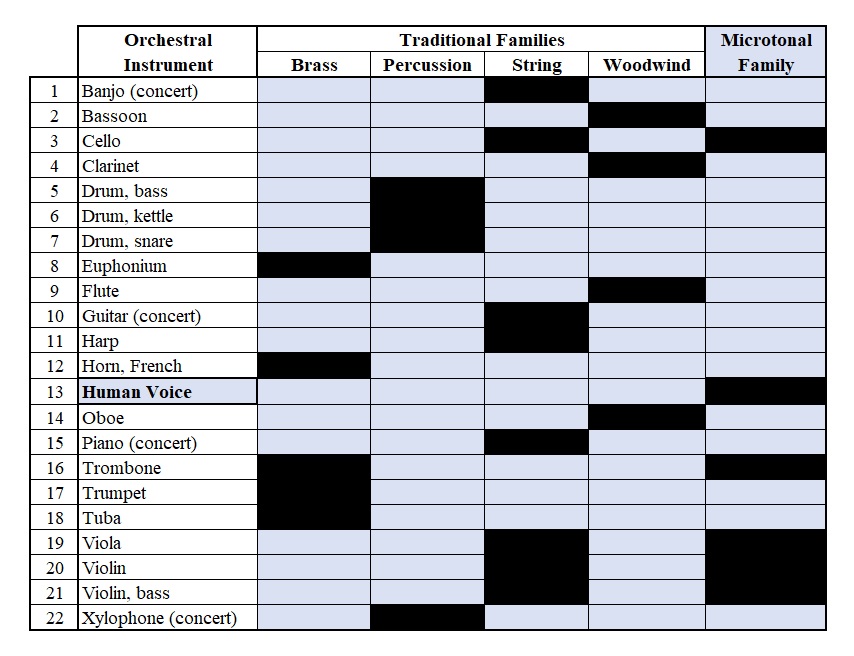|
Copyright ©2021 by Paul Niquette All rights reserved. |
People who create puzzles will agree that selecting each title is a bit of a challenge. One wants to generate curiosity -- but not give away the solution. I decided to obtain ideas from my guests by devising a game...Holding up four fingers, I declared, "Based on how their sounds are made, there are four traditional families of musical instruments in an orchestra, can you name them?" With a little persuasion, all agreed on strings, brass, percussion, and woodwinds for the names. That part was easy. "There is one attribute shared by some instruments in the traditional families that others do not," said I. "That attribute needs a name for my puzzle." To head off extraneous guesses ('strumming', 'plucking', 'bowing', 'blowing',...), I smiled and said, "Name any instrument, and I will tell you whether it has the attribute-in-question or not."Many of the orchestral instruments were named one by one by the people at the table -- hey, without access to the photograph and the tabulation in the Scale Steps puzzle. My yes/no answers brought a smattering of grins and a few frowns. The trombone received a 'yes' and the trumpet received a 'no'. Then suddenly, "Aha!" -- the sound of discovery: "The trombone has its pitch controlled by a sliding tube. The trumpet has valves and thus plays only discrete notes." Observations swirled around the table: woodwind instruments can only play chromatic scales; string instruments, from violin to cello to bass, can all play infinitesimal scales -- hey, except for the harp and the piano. Had any guest mentioned either guitar or banjo, their host would have brought into the conversation the subject of frets, which enforce fixed Scale Steps on string instruments.As shown, in the solution below, the "Mystery" instrument is the human voice, which would not be included among "Traditional Families." One famous televised performance -- seen by a billion viewers! -- featured the "Microtonal" musical gifts of Aretha Franklin in her 1998 "soul infused" performance of the aria Nessun Dorma. Indeed, the human voice does have the attribute-in-question, alongside orchestral strings. And the trombone. Glissando.  "Microtonal" Proposed
for an Attribute of Certain Musical Instruments
Other choices considered: tonalità
infinitesimal and étapes infinitésimales.  ...and that would sure be difficult for an instrument designed to play only twelve tones per octave, as indicated in the table above. How is it even possible? The secret is revealed in an expert teaching demonstration (7:00). The same challenge applies to the flute, for which a similar technique is taught here (6:35). Oh, but there is a super idea for a full range of creative effects on the flute, but all are quite inconvenient for the clarinet. Listen to the breathy flauta y vocale by María Emilia Martínez, highlighted in Misirlou (2:55/8:04).Powered by its microtonality, the trombone glides between notes at will and readily provides orchestral sweeps and swoops -- aspects fully exploited by Leonard Bernstein in the New York Philharmonic's crescendo at the end of Bolero (14:00/14:20). Violins can do the same. And something else: screech, like on purpose. For example, in a sound track for a horror movie. Glissando or its younger brother portamento can come in handy for orchestral sound effects, as playfully performed on several instruments in Ferde Grofé's Grand Canyon Suite (13:43/35:36). As a joke on Gershwin... "Ross Gorman, Whiteman's virtuoso clarinetist, played the opening measure with a noticeable glissando, 'stretching' the notes out and adding what he considered a jazzy, humorous touch to the passage. Reacting favorably to Gorman's whimsy, Gershwin asked him to perform the opening measure that way and to add as much of a 'wail' as possible." -- Greenberg, Rodney (1998). George
Gershwin. London: Phaidon Press.
Epilog: Your musical comments and links are invited for sumittal here. An elderly engineer (that would be me)
appreciates the musical consultations provided by Jeff
Kaser and John Swanson. |